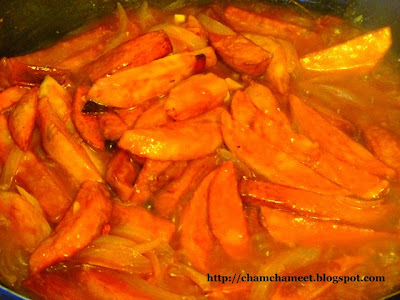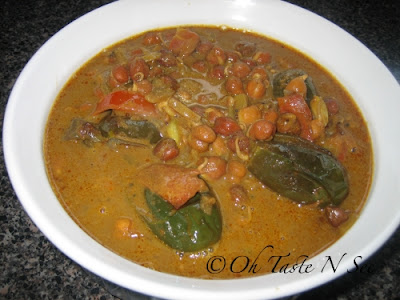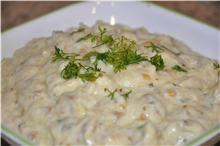Kayi Holige / Coconut Poli
Holige = Obbattu = Holiga = Poli = Bobbattlu => A sweet delicacy from India
Yes, I have saved the best for the last part of my CFK.
I grew up and have spent two thirds of my life in a state where every celebration, bigger or smaller is impossible with out holige / obbattu on the menu. It would have been a shame if I had not posted a holige recipe when I am hosting an event that is dedicated to festive foods. I see all Kannadigas nodding their heads. :) Holige plays a major role in Karnataka cuisine and this delicacy enjoys a 'royal' status there. 'Holige oota' - The food including these sweet flatbreads is considered to be the ultimate feast one can serve to their guests. Festivals, engagements / marriages, graduations, welcoming home a new son-in-law or a baby, a new home / job (for that matter, any reason under the sun that one can think of that has brought joy to life) has to be celebrated with these holiges, of course lovingly prepared by dear mothers or chefs if prepared on a big scale!
Holige making is considered an art and usually the job is reserved to the experienced matron figure of the family. As I mentioned above they are flat breads with a sweet stuffing. The usual traditional stuffing can be pureed toordal / chanadal or coconut ones sweetened with jaggery and flavored with aromatic cardamom. Usually when moongdal filling is used, sugar is the preferred sweetener. I have noticed that even a traditional poli could become versatile depending upon one's creativity and experiments. Now coming back to the traditional ones, kayi holige or kayobbattu is said to be one of the tougher ones to nail down. They are supposed to be wafer thin and some experience helps in perfecting them. My mom usually prepares and prefers coconut stuffed ones since they can be stored longer, about a month or so with out any refrigeration. Some stores in Bangalore sell them in plastic packets because of their long shelf life.
The outer layer uses the chiroti rave along with maida. Chiroti rave happens to be finer semolina than the regular version that is used to prepare upmas. As the name suggests, it is used in preparation of another delicacy from the state, chirotis. Chirotis happen to be one more sweet delicacy from Karnataka and usually appear on wedding menus. Their preparation is left to seasoned chefs since the preparation process happens to be an elaborate one.
The following ingredients make around 22 obbattus. My mother though added the ingredients for the stuffing and the dough with out any measuring tools, they were perfect. We were not left with any of the stuffing or the dough.
Since I don't do pictorial explanations, I didn't take pictures for each step. I will try to update the post with new images for a better understanding of the recipe.
Ingredients for the stuffing:
4 cups finely shredded fresh coconut*
3 cups powdered jaggery (or less if you find the mixture sweeter)
1 tsp powdered cardamom
* It is important to note that the coconut needs to be very finely shredded. I had used the frozen, shredded coconut and since the gratings were larger, I just ran it through food processor for a minute so that it was finely shredded.
Preparing the stuffing:
Add everything to a thick bottomed or a non-stick pan and start cooking on medium low flame till it thickens. It took me around 25 minutes to cook it. To know whether it is done, do this test. Take a tsp of the stuffing, make it into a ball and try to pat it on a plastic sheet with your fingers. You must be able to spread it with out any difficulty. It should not curl back.
Let it cool. At this stage, either you can use it to prepare holiges or can refrigerate it to use later. It can be stored refrigerated for at least a couple of weeks. This step can hence be done very well in advance.
Ingredients for the outer layer:
Chiroti Rava / Very fine semolina - 1 & 1/4 cups
Maida / All Purpose flour - Half the quantity of rava
Oil - 6 to 7 Tbsp
Preparing the dough for the outer layer:
Combine the flour and rava in a bowl. Add sufficient water (I added about 1 cup minus 1 Tbsp) and make a thick dough as roti / poori dough. Then add the oil gradually and keep kneading so that the oil gets incorporated well into the dough. According to my mother's instructions I kept kneading it for at least 15 minutes. My mother swears that this much of kneading (and the addition of that much of oil too) is really important and one shouldn't skip this step.
Let the dough rest for about 30 minutes.
Making obbattus:
* Pinch about a small lime sized dough and place it on a greased banana leaf or a thick plastic sheet that is greased.
* Now using your fingers, pat and flatten it into a thin circle of about 3 inch diameter.
* Place about a lime sized ball of stuffing at the center of the dough circle. Bring the edges of the dough from all sides to cover the stuffing completely. Now the stuffing should be well inside the dough casing.
* Again flatten it with your fingers and go on patting it carefully so that it results in a thin, flat circle with stuffing not spilled out. Take care that the edges have stuffing too so that you don't end up eating hard edges.
The below one was stuffed by me on my first trial and hence looks like that.:)
* Meanwhile heat a griddle / tava / or a shallow pan. Now place the disc on it and fry it both sides till it is done by flipping it once or twice and adding a half spoon of oil / ghee around the edges while doing so.
* Repeat the procedure with the remaining dough and the stuffing. You can prepare the discs and do the frying part simultaneously.
Enjoy them with a spoon of melted ghee.
Cool the rest and store them in an airtight container. They remain good atleast for a month, unrefrigerated.
I am really glad to send them over to my CFK - Festive Foods, an event originally started by Sharmi.
Post a comment












%5B1%5D.JPG)
























































